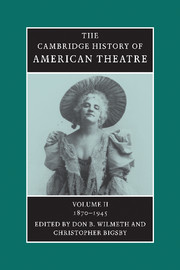Book contents
- Frontmatter
- Introduction
- Timeline: Post-Civil War to 1945
- 1 The Hieroglyphic Stage: American Theatre and Society, Post-Civil War to 1945
- 2 A Changing Theatre: New York and Beyond
- 3 Plays and Playwrights
- 4 Theatre Groups and Their Playwrights
- 5 Popular Entertainment
- 6 Musical Theatre
- 7 Actors and Acting
- 8 Scenography, Stagecraft, and Architecture
- 9 Directors and Direction
- Bibliography
- Index
8 - Scenography, Stagecraft, and Architecture
Published online by Cambridge University Press: 28 March 2008
- Frontmatter
- Introduction
- Timeline: Post-Civil War to 1945
- 1 The Hieroglyphic Stage: American Theatre and Society, Post-Civil War to 1945
- 2 A Changing Theatre: New York and Beyond
- 3 Plays and Playwrights
- 4 Theatre Groups and Their Playwrights
- 5 Popular Entertainment
- 6 Musical Theatre
- 7 Actors and Acting
- 8 Scenography, Stagecraft, and Architecture
- 9 Directors and Direction
- Bibliography
- Index
Summary
Architecture
The post-Civil War years ushered in an era of unprecedented and widespread theatre building in the country. By 1880, according to the most often quoted estimate by the critic William Winter, there were approximately five thousand theatres in thirty-five hundred cities and towns across America. Disparate forces – evolutionary and revolutionary, internal and external – abetted the proliferation of theatres and were responsible for an extended period of growth that lasted more than fifty years. In the immediate postwar years, the now united country was on the verge of enormous change. The steady flow of population pushing west predicted the time when the geography of the country would extend from the east to the West Coast. When the Gold Rush of 1849 propelled the sleepy California territory into a state the following year, it was even more imperative that the country be united. Fortunately, the means to accomplish this event were at hand or in the process of being developed.
When Congress passed the Pacific Railroad Act and the Homestead Act in tandem in 1862, the spectacular growth of the country was assured. Thousands of miles of railroad track were being added each year and would meet in 1869 in a remote area in Utah to unite the country from coast to coast. The population followed the railroad and “cities sprang up where nature once reigned.” History repeated itself again and again in the westward push as settlement became town and town became city along the route of the railroad.
- Type
- Chapter
- Information
- The Cambridge History of American Theatre , pp. 487 - 513Publisher: Cambridge University PressPrint publication year: 1999
- 1
- Cited by



